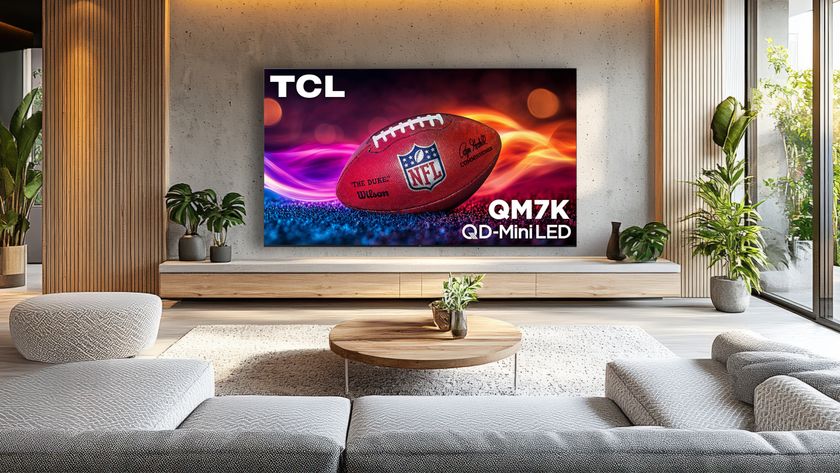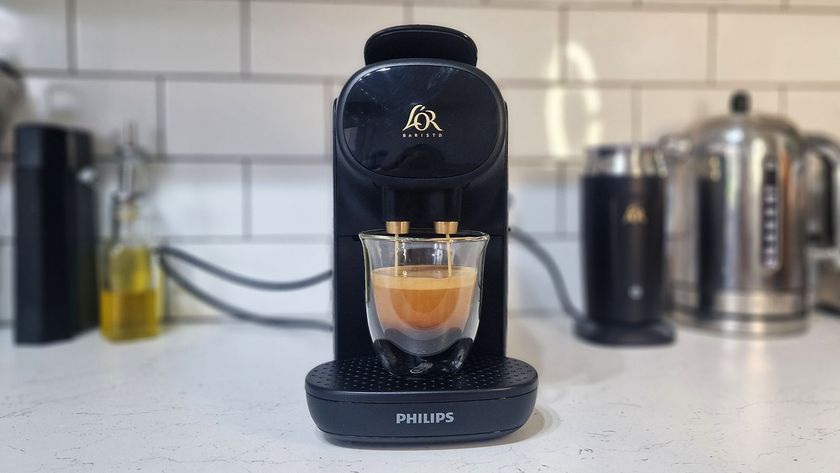Tom's Guide Verdict
The Sansui OLED is one of the cheapest OLED TVs in the market, but its low cost leaves a lot on the table. What it does have are the perfect black levels and wide viewing angles of an OLED display. Unfortunately, given its subpar brightness, glare is a major problem. At $799, the price is right, but its overall performance and lack of features might leave you wishing you sprung for a better OLED TV.
Pros
- +
Cheaper than most OLEDs
- +
Great color
- +
120Hz refresh rate
Cons
- -
Heavy glare issues
- -
Very slow interface
- -
High input latency
- -
No ATSC 3.0 tuner
Why you can trust Tom's Guide
When browsing the best OLED TVs on the market, it’s rare to find one with an affordable price tag. Even for those that are value-oriented, OLED TVs typically come at a high premium. The 55-inch Sansui OLED TV is here to change all of that. It’s not here to be the best, it’s simply here to be among the most affordable.
At $799, it seems like a great way to save money on an OLED, but that price comes with several caveats that you may want to consider first. Simply put, there are better options on the market.
Sansui OLED TV review: Price and release date
Sansui launched its OLED TV earlier this year in September at the low price of just $799. It’s only available in a 55-inch configuration. If you’re unsure what size TV you should get, check out our ‘What size TV should I buy?’ guide, as TVs are getting bigger and bigger and you may want something slightly larger depending on the size of your living room.
- 55-inch Sansui OLED TV (55VOUG): $799 ($599 on sale)
Compared to other 2024 OLEDs on the market, the Sansui OLED sits closest to the LG B4 and Samsung’s S85D, whose 55-inch models come in at around $1,100 and $1,299 respectively. Additionally, the Sansui OLED is only available at select retailers, including PC Richard & Son, Micro Center, and Walmart.
Sansui OLED TV review: Design

The Sansui OLED is surprisingly heavy, weighing around 74 pounds, largely due to its hefty base, which is actually a welcome touch. Unlike other TVs in its class, the Sansui OLED has a pedestal design that makes it easier to place on smaller, narrower surfaces. Even with the stand, it’s a flexible setup, with its depth just over 9-inch and its height around 29-inch.


Its 300mm x 300mm VESA mount compatibility makes it super easy to pair with one of the best TV wall mounts. A 20W speaker on a 2.1-channel system isn’t the most ideal audio arrangement in town, but it’s better than nothing.
Sansui OLED TV review: Ports
The Sansui OLED comes with a range of ports that covers most needs across various connected devices. It features four HDMI inputs, only two of which are 2.1 compatible. Although that might come as a disappointment to people with a wide array of devices, this concession is in line with the Sansui OLED’s price point. (It’s worth noting, however, that both the LG B4 and the Samsung S85D come with a full suite of four HDMI 2.1 inputs.)

The Sansui OLED TV also comes equipped with an audio output, Digital audio output, Ethernet port, and one USB interface. For wireless connectivity, it also offers Wi-Fi dual-band and Bluetooth 5.0. Unfortunately, mirroring LG’s 2024 TV lineup, the Sansui OLED TV is without an ATSC 3.0 tuner, which means you won’t have access to NextGenTV and 4K broadcasts.
Sansui OLED TV review: Performance
As always, I put the Sansui OLED TV up to the test in a variety of different scenarios. I watched a lot of darker content to test the Sansui OLED’s anti-glare capabilities during shows like “The Penguin” and “Dune: Prophecy.” While the Sansui OLED maintained a good amount of shadow detail thanks to its OLED display, strong glare from other light sources proved a major foil. One reason for this is that the Sansui OLED is quite dim, even when displaying HDR content. In fact, it’s the dimmest OLED we’ve tested all year. The TV’s ability to display perfect black levels helps its overall contrast, but if you’re hoping for an OLED TV that showcases HDR with incredible highlights, the Sansui OLED will disappoint you.

It also struggles in upscaling YouTube videos to 4K, which most likely owes to its custom chip. This is a significant mark against it, given how impressed we’ve been with the picture processing of LG and Samsung OLEDs this year.

That said, a highlight for me has been vibrant content, particularly animated series like “Dandadan” and “Dragon Ball: Daima,” which really popped on the screen. This extended to games, too, like “Elden Ring,” “Armored Core 6” and “EA Sports FC 25.” The Sansui OLED isn’t as accurate out of the box as competitive OLEDs like the LG B4, but it offers decent color volume.

Unfortunately, when it comes to gaming-specific features, the Sansui OLED is lacking. It features a native refresh rate of 120Hz, but you won’t get the full toolbox of gaming features that both LG and Samsung TVs offer (like LG’s Game Optimizer mode and Samsung’s Game Bar). Its input lag is much higher than those competitors, too.

Like all OLEDs, one of the Sansui’s built-in benefits is that it offers more accommodating viewing angles than most LED TVs. It’s not perfect, though, as you’ll still lose some details when watching from an off-axis seat. It’s minimal compared to LED TVs in this price range, but disappointing compared to other OLED sets.
How we test
We follow a standard testing protocol for every TV we review at Tom’s Guide. Our benchmarks include a series of technical and subject tests designed to rate the set’s performance. For our technical tests, we use a Jeti spectraval 1501-HiRes spectroradiometer, a Klein K10-A colorimeter, a Murideo 8K-SIX-G Metal pattern generator, and Portrait Displays’ Calman TV-calibration software to take measurements. We also use a Leo Bodnar 4K Input Lag Tester for determining the TV’s gaming prowess.
Subjective tests vary based on the reviewer, but usually feature anecdotes from a diverse selection of movies, TV shows, and other content reflecting the types of things you may actually want to watch on the TV.
Sansui OLED TV review: Test results
How does it stand against better-known OLED TV manufacturers? We put the Sansui OLED TV up to the test against the market’s most budget OLED offerings as well as Sony’s most affordable Bravia LED TV.
| Row 0 - Cell 0 | Sansui OLED TV | LG B4 | Samsung S85D | Sony Bravia 3 |
| SDR Brightness (10%, in nits) | 406 | 631 | 680 | 448 |
| Delta-E (lower is better) | 4.2 | 0.9 | 1.9 | 3.5 |
| Rec. 709 Gamut Coverage | 129.93% | 97.55% | 108.87% | 99.71% |
| HDR Brightness (10%, in nits) | 427 | 641 | 684 | 447 |
| UHDA-P3 Gamut Coverage | 97.67% | 99.39% | 98.57% | 95.88% |
| Rec. 2020 Gamut Coverage | 72.04% | 76.53% | 74.17% | 73.07% |
| Input latency (in milliseconds) | 21.2 | 9.7 | 9.2 | 9.8 |
While it’s a significantly cheaper model with different display technology (direct LED) I’ve included Sony’s Bravia 3 LED TV to illustrate how close in performance the Sansui OLED is to an entry-level LED TV. The B4 and S85D are relatively dim as far as OLEDs go, but they’re still brighter than the Sansui by a considerable margin.
On the gaming side of things, its biggest drag is a seriously high input latency of 21.2ms — well over the sub-10ms we like to see on most sets.
Sansui OLED TV review: Audio
I will give the Sansui OLED some credit. While it might not have the most powerful speaker on paper (listed with a mere 20W output in tandem with a 20W internal subwoofer), it gets the job done — at least when it comes to pure volume. I never had to raise it over at least 20 (out of 100), but the sound quality itself leaves a lot to be desired.
Given that most TVs don’t often come with great audio, we tend to recommend nabbing one of the best Dolby Atmos soundbars, especially if you want a more robust atmosphere for your home entertainment setup. Not every OLED can be like the Panasonic Z95A and its bombastic 160W speaker system, but the Sansui OLED does have Dolby Atmos support, and a well-rounded soundbar can make all the difference.
Sansui OLED TV review: Interface and apps
It comes as no surprise that the Sansui OLED TV runs on Google TV, as the smart platform is now winning the TV interface race. That’s OK with me, as Google TV is not only super easy to set up, but incredibly streamlined and hassle-free.

It’s also home to a wide swath of free content, now corralling even the Roku Channel, among others. If that wasn’t enough, Google TV likewise has access to all of the best streaming services, so you’ll never be without your daily reruns of “Friends” and newer shows like “Star Wars: Skeleton Crew.”

Google TV is nice to have, but I’ve got plenty of complaints about the overall software experience. I’ve experienced sluggish navigation on top of even slower alternative commands, like changing inputs, accessing the settings menu and even powering the TV on. This reflects poorly on the TV’s internal chip rather than the software layout, but whatever else Sansui’s added on top of Android 11 definitely isn’t making the interface more user-friendly.
Sansui OLED TV review: Remote
Sansui offers its own branded remote, which has quick access buttons to several of the most popular TV apps, including YouTube, Netflix, Disney Plus, and Amazon Prime. There’s also a closed caption button for enabling that setting on the fly, plus a handy Google voice function for easier searches.

Sansui’s remote is longer than most, but narrower and more lightweight, making it easy to hold. Unfortunately, it falls into the trap of using AAA batteries rather than solar or USB-C charging like its Samsung and Roku rivals. There are numbered buttons at the top of the device above the navigation circle, too. This might be nice for some users, but in my experience, it just adds unnecessary space to the remote.
Sansui could easily slim its remote down and add USB-C charging to make this a fine fixture. It’s got almost everything else you could ask for, including four colored user-generated quick access keys and a dedicated button for settings and changing inputs. A microphone doesn’t come included, unfortunately, which might disappoint viewers who rely on easy-access voice commands.
Sansui OLED TV review: Verdict
The Sansui OLED’s shockingly low price (relative to competitive OLED TVs) is certainly a bold statement. Ultimately, I hope it forces other brands to lower the cost of their entry-level OLEDs. However, I don’t think it’s a good fit for most people shopping for a budget-friendly OLED, especially given better options like the LG B4.
I appreciate the Sansui OLED’s familiar Google TV platform, which most people will recognize and be able to use without much friction. But its incredibly sluggish UI, limited gaming features and missing ATSC 3.0 tuner make it a hard sell in this crowded, competitive price range.
Although $200 to $300 more expensive, the 55-inch LG B4 OLED is a far more compelling offer. It’s built with that same WOLED panel, offers better brightness and a superior gaming experience (for the “Black Ops 6” and “Black Myth Wukong” fans in the house). That’s about the best deal you’ll find on an OLED worthy of purchase, but even then, you could always find a much more compelling OLED model within last year’s lineups.

Ryan Epps is a Staff Writer under the TV/AV section at Tom's Guide focusing on TVs and projectors. When not researching PHOLEDs and writing about the next major innovation in the projector space, he's consuming random anime from the 90's, playing Dark Souls 3 again, or reading yet another Haruki Murakami novel.























